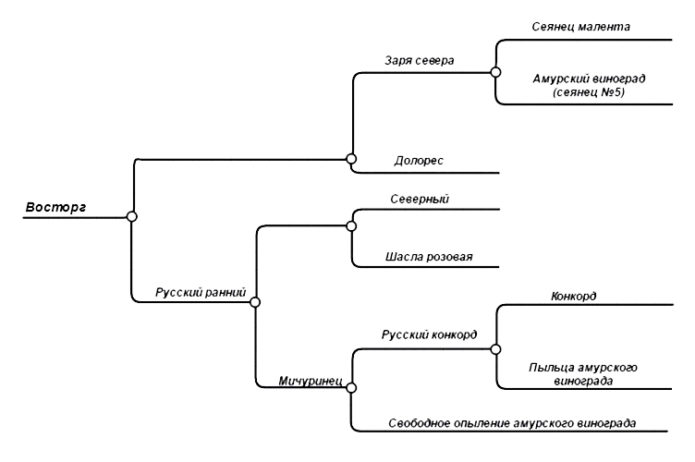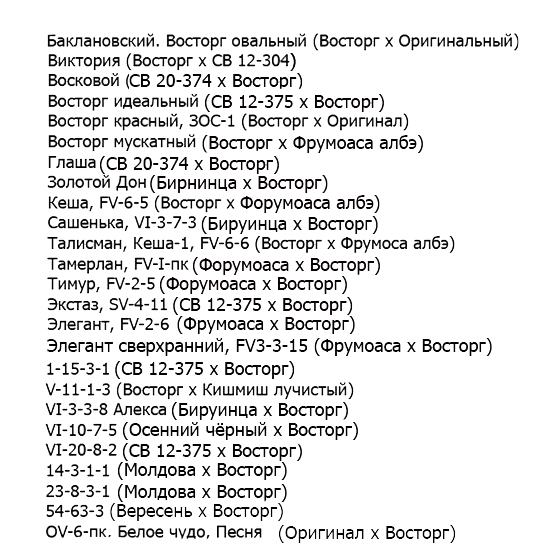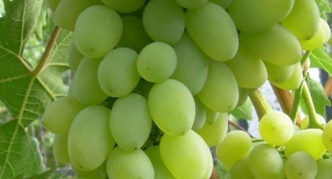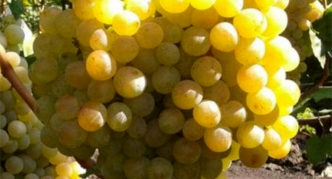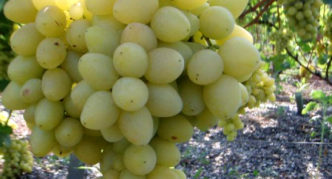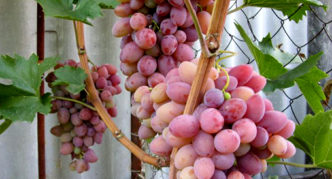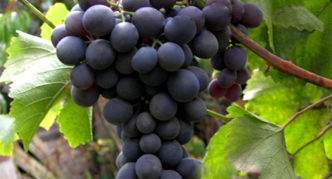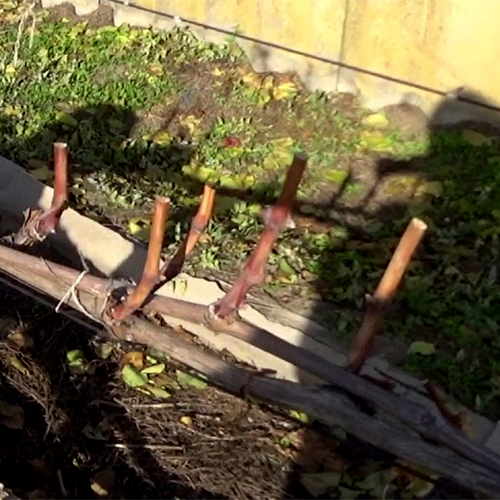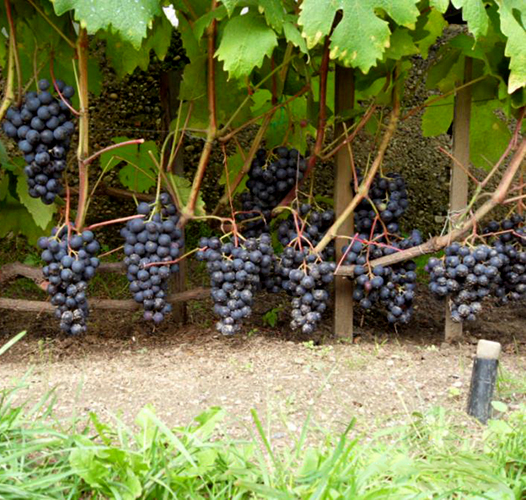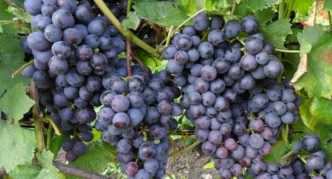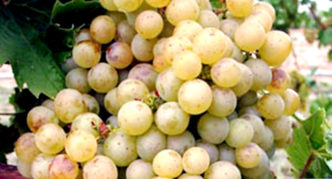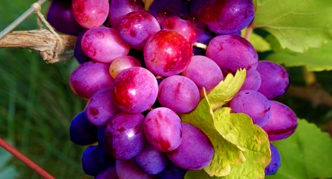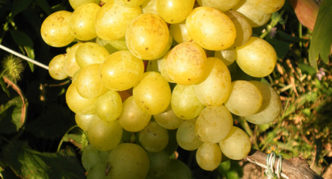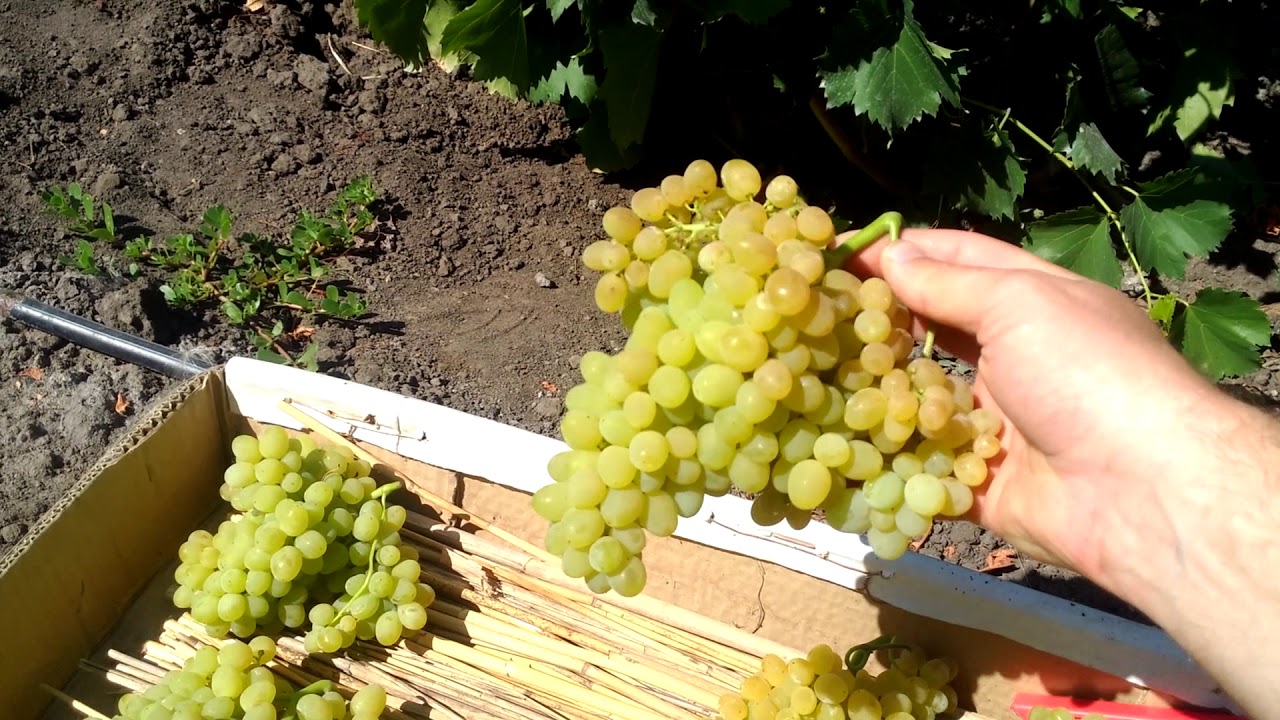Many years ago, Russian breeders bred the frost-resistant grape variety "Delight", which is still grown everywhere from Siberia to Crimea.
Content
How Rapture was created
In the sixties of the last century, at the Research Institute of Viticulture and Winemaking of the RSFSR (now the VNIIViV named after Yakov Ivanovich Potapenko), three scientists breeders bred the grape variety Delight. Ya.Potapenko, I. Kostrykin and A. Skripnikova took the Amur wild grapes as the basis for breeding work. Through many crosses and cross-pollination, they managed to get a frost and disease-resistant plant with large berries and bunches weighing up to 700 g.
On the basis of the Vostorg variety, at the same time, many varieties of this grape were created in the NIIViV of the RSFSR.
In the name, only 4 varieties retain the name of the progenitor:
- Oval delight (Baklanovsky);
- Delight is perfect;
- Muscat delight;
- Delight is red.
There is also Black Delight. It was obtained during the selection of the main variety, by crossing three varieties: Russian early x (Dawn of the North x Dolores).
Table of characteristics of varieties of table grapes Delight
| Variety name | Before harvest (days) | Winter hardiness | Berry color | The weight bunches (g) | The weight berries (g) | Yield (t / ha) | Other characteristics |
| Delight * (white) | 90–110 | -25 ° C | white | 700 | 5–6 | 1,2 |
|
| Delight is perfect | 120–125 | -26 ° C | white | 800–1000 | 5–6,5 | 1,2 |
|
| Nutmeg delight | 105–115 | -27 ° C | white | 350–500 | 4,5–5,2 | 0,9 |
|
| Baklanovsky (Oval Delight) | 120 | -25 ° C | white | 598 | to 10 | 1,14 |
|
| Delight red | 130 | - 25 ° C | dark pink | 600–900 | 6–7 | 1,3 |
|
| Delight is black | 115–125 | -25 ° C | dark blue | 450–750 | 8–9 | 1,5–2,0 |
|
* Delight white - the popular name of the variety Delight.
The progenitor of Timur and Timur pink grapes was the famous Delight variety, bred about fifty years ago by complex breeding at the Research Institute of Viticulture and Winemaking of the RSFSR (now VNIIViV named after Yakov Ivanovich Potapenko):https://flowers.bigbadmole.com/en/yagody/vinograd/vinograd-timur-opisanie-sorta-foto-otzyivyi.html
Bunches of grapes of the Rapture family - photo gallery
- Bunch of Baklanovsky grapes
- Bunch of grapes Delight
- A bunch of grapes Delight perfect
- Bunch of grapes Delight red
- A bunch of grapes Delight nutmeg
- A bunch of grapes Delight black
Features of grape varieties of the Rapture family
Planting and caring for grapes Delight of various modifications is standard. Only when planting should it be borne in mind that vigorous vine bushes need a large feeding area. If several plants are planted in rows, then a distance of 6 m is left between them, and between rows 2–3 m. Single plants also need a significant area for the installation of supports, not shaded by other plants. The most important points in growing these varieties are pruning in the fall and green operations in the summer. If these operations are not given enough attention, then a large mass of shoots will deplete the bush, which will negatively affect the quantity and quality of the crop.
Delight
Delight, due to its strong growth, is prone to crop overload. Therefore, they begin to cut it from the first year of life. The bush is formed in such a way that it has the opportunity to accumulate a large supply of perennial wood over time. It better provides nutrients for a large harvest of large berries. When forming a grape bush, Delight does not leave replacement knots on the main vine, but only shortens it. The main vine in viticulture is called a branch or sleeve. The vines of the current year are cut very shortly in the fall. 3-4 buds are left on them, from which fruiting vines will grow next year. Such knots are left at regular intervals on one side of the old vine. Their number is calculated so that a total of 35 to 45 kidneys remain. This type of pruning is called a short cut. If they want to get larger brushes, then leave so many knots so that they have 20-30 buds. In most cases, growers call these buds eyes.
On adult bush of Delight, it is recommended to pick off the leaves shading the bunches of berries. With a lack of sunlight, very little sugar is formed in the fruit.
Video about the grape variety Delight
Delight is perfect
Powerful high-yielding plant. For this variety, high-standard formation or cultivation on arches, arbors is preferable. For gazebos, three main vines (sleeves) are formed - two horizontal and one vertical. In order to give the bush such a shape, in the first autumn (if planted in spring) three shoots are left. The length of two vines, which will be fixed horizontally in spring, is determined as follows: the shoot should reach the first row of the arbor's wire and have 3-4 more internodes with buds. The vine, which will be fixed vertically in spring, is shortened to mature wood. In the spring of next year, the shoots are attached to the wires of the gazebo. All buds below the first row of wire are removed. On a vertically attached shoot, 3-4 upper eyes are left for fruiting. This operation is called vine blinding. The blinded areas of the shoots will gradually build up perennial wood and subsequently become sleeves and a high stem. In the fall, the same trimming is done on the sleeves as described for the Delight variety. The same operations are carried out on the trunk as last year. It is shortened only to mature wood. When the shoot grows to the upper edge of the gazebo, two sleeves are also grown there. The full formation of the bush takes 4–5 years. In the sixth year of life and in the future, on the grapes of the Vostorg variety, they make a short pruning into horns. Leave so many horns so that a total of 35 or 45 eyes are on them. If 25 eyes are left for fruiting, then clusters weighing more than a kilogram can grow.
Video about grape variety Delight perfect
Nutmeg delight
The vigorous plant of Muscat's Delight differs from its counterparts in a large number of fruitful shoots. Bunches of berries grow on 80–95% of the vines this year. Such abundant fruiting requires particularly careful control over the load of the bush with the harvest. When autumn pruning of grapes leaves knots with only 20–25 buds on each plant of this variety. If the pruning is done for 5-8 buds, then only 3-4 vines are left on the bush, on which bunches of berries will grow next year. Several bunches may form on many shoots of the current year. Therefore, the rationing of the bush in summer is of great importance. Muscat Delight is very frost-resistant, which allows it to be grown on arbors and arches. For this, the bushes are formed with the growth of perennial wood. They are cut by 3-4 eyes, but the number of buds should remain the same - 20-25 pieces. This variety of Rapture thrives on sandy soils.
Video about the grape variety Muscat Delight
Baklanovsky (Oval Delight)
The bush of this variety of Rapture is vigorous, forming many inflorescences in the lower part of the vine (close to the sleeve). Most often it is grown on trellises. In the fall, the vines of the current year are cut into 8-10 eyes. The lowest kidney is not taken into account, because in the spring it will need to be broken. This is done so that the clusters are laid further from the ground. This gives better lighting and ventilation of the bunches. After pruning in the fall, 40 buds should remain. This number is considered standard for Baklanovsky grapes. If you want to grow bunches with larger berries, then the bush is formed by pruning on horns to grow perennial wood.
Video about the Baklanovsky grape variety
Delight red
The bushes of this grape variety are medium-sized. The food area for them should be at least 6 m² each. Fruit buds are laid only on half of the shoots of Red Delight. Therefore, in the fall, its vines are cut into 8-14 eyes. Abandoned kidneys can be from 40 to 55 pieces. The standardization of the volume of green mass and the number of bunches is performed by summer operations:
- wreckage;
- pinching;
- minting.
If they want to grow these grapes on gazebos or arches, then they choose autumn pruning on a horn with the growth of perennial wood. When the bush is formed for such supports, then 20-25 eyes are left during pruning. With this formation of the bush, the clusters are better illuminated and colored. Brightly colored clusters with large berries acquire a good presentation.
The Red Delight variety became one of the parents of the unique frost-resistant Azalea grape, which is distinguished by a strong vine and early ripening berries of an interesting color:https://flowers.bigbadmole.com/en/yagody/vinograd/vinograd-azaliya-opisanie-sorta-foto-otzyivyi.html
Video about grape variety Red Delight
Delight is black
Black Delight bush has great vigor and high fruitfulness of shoots at the base. The bushes of this plant are formed with the growth of perennial wood. Pruning is done for 3-4 buds, not counting the lowest one. They break it off in the spring. The total number of buds on grapes of this variety should be 40-50 pieces. If the pruning of vines of the current year is made long - by 10-12 eyes, then the distance between the knots should be three times greater. In the Black Rapture, 75–85% of the shoots of the current year bear fruit. The load of the bush with crops and green shoots is regulated by summer operations:
- wreckage;
- pinching;
- pinching;
- minting.
During the period of bud formation or at the earliest stage of flowering, the tops of fruiting shoots are pinched. After such an operation, the growth of the vine stops. The plant directs all nutrients to fruit setting and berry ripening in the future.
How grapes are chosen
In order to choose a grape variety for cultivation on your site, you need to determine what you will use its fruits for. There are technical and table varieties. Technical - for making wine, raisins and juices. Canteens - for fresh consumption. In table varieties, the bunches and berries are much larger. When breeding these varieties, breeders achieve a harmonious taste, aroma and attractive color of berries.For technical varieties, the main indicators are the mechanical and chemical composition of grapes.
In summer cottages and in small farms, table grapes are most often grown. Grapes are chosen according to several criteria:
- ripening period - how many days will pass from budding to harvest;
- winter hardiness - what is the minimum temperature that grapes can withstand without damage to the plant;
- bunch weight - how large it is;
- berry weight - it characterizes the size;
- yield - how many fruits will this grape give;
- sugar content / acidity - characterize the taste of the fruit.
The table shows the characteristics of several grape varieties, selected for winter hardiness and ripening times. It shows that the grapes of the Rapture family surpass similar varieties in taste, and often in the size of berries and bunches.
| Variety name | Before harvest (days) | Winter hardiness | The weight bunches (g) | The weight berries (g) | Yield (t / ha) | Sugar content / acidity |
| Hall Dend | 120–125 | – 24° | 170–270 | 5–6 | 1,2–1,4 | sugars up to 15-18%; acidity 4–5 g / l. |
| Delight is perfect | 120–125 | – 26° | 800–1000 | 5–6,5 | 1,2 | sugar content 16–19%; acidity 5–7 g / l. |
| Muromets | 100–110 | – 25° | 400 | 4–5 | 1,0 | sugar content 17 - 19% acidity 6–7 g / l; |
| Delight | 90–110 | – 25° | 700 | 5–6 | 1,2 | sugars up to 26%; acidity 5-9 g / l. |
| Cubatic | 105–115 | –27° | 705 | 4–5 | 1,8 | sugar content up to 17%; acidity 5 g / l. |
| Nutmeg delight | 105–115 | –27° | 350–500 | 4,5–5,2 | 0,9 | sugar content up to 25%; acidity 5–6 g / l; |
There are general recommendations of growers on the layout of plants on the site. The placement of rows from north to south or from east to west is considered optimal, but in practice this advice is not always followed, more often it comes from the shape of the site, the presence of buildings and other objects on it:https://flowers.bigbadmole.com/en/yagody/vinograd/na-kakom-rasstoyanii-sazhat-vinograd-drug-ot-druga.html
The grape varieties shown in the table, in the photo
- Bunch of grapes Muromets
- A bunch of grapes from the Hall of Dandy
- The characteristics of Delight ideal are compared with those of the grapes of the Hall of Dandy
- Bunch of grapes Kubatik
- The characteristics of Muscat Delight are compared with the data of Kubatik grapes
- The characteristics of Rapture are compared with the data of the Muromets grapes
The advantage of all these varieties, including Rapture, is resistance to fungal diseases and rot. And their disadvantage was the susceptibility to a pest that appeared several years ago - phylloxera. You can fight it only by disinfecting the planting material. Chemicals for phylloxera root have not yet been developed.
Reviews of winegrowers about the Rapture family
The Rapture family is a real very weighty FAMILY. All are good. Delight I like the taste and the fact that there are no problems. The crop hangs on the bush for up to two months and nothing happens to it, it just becomes even tastier. Baklanovsky (Original Delight) is generally a fairy tale, even the first fruiting delights. The ideal one does not concede and does not hide at all and behaves perfectly. Muscat delight is also very good, only a couple of preventive treatments for oidium and fungal diseases are needed (I did not observe diseases during preventive treatments). Muscat delight, like ideal, is good in high-standard culture. And Red Delight is a handsome man, you will lick your fingers! I can't say anything about Black Rapture. A young bush nulevka was planted in 2008 in the fall. We must speak separately about the Vostorg family and thank you very much for these varieties !!!
Hello! Individual berries of the Delight variety can be pinched on July 25, but if we talk about full maturity, then around August 10-15, the first harvest of this variety is done. This can be seen from the tasting scores - Delight goes as a control, so it usually participates in the first 2-4 tastings. As it matures, the score improves. Delight has a good berry size. The average berry weight below 5 g is rare. But we must also take into account that we have a completely grafted Delight. But I saw in one comrade Delight on the arch was own-rooted, the weight of the berry was about 8 g and the pods were good, the load in bunches was also good.Rapture is often complained of that it fails. It seems not capricious, but for some reason it reacts sensitively to the microclimate of the growing zone. Best regards, Svetlana
Delight is perfect, a wonderful variety! I have subsoil waters of 1.5 m. This is where Delight and the Talisman show what they are capable of. They do not chlorose, the berry is 10 g or even more about the Talisman in general for the berries. since 25 July. It hangs until frost and is not afraid of anything. This year, I really can’t say anything. I’ve not ripened yet. I have it on the arch. After winter 2006, it was one of the best. Sincerely, Alexey.
Hello dear. And these "cannabis" in Rapture do not bother me, on the contrary, they give the grapes a ripe look. But I tried Baklanovsky this year, in different stages of maturity. And he decided to throw it away even before the beginning of fruiting ... The only thing he wins from Rapture is its presentation. The taste is herb herb, even in September. In this regard, to Rapture, he is like walking to China
The Perfect Delight grows with me. This is one of my favorite varieties. I never got sick with anything (with 4 treatments), but it can be affected by a tick at the beginning of the growing season. The growth force is very strong, it can handle any load. Early variety. When overloaded, ripening is delayed, but always ripens. If not rationed, then the bunches are 500g, rationed - 1kg. Bunches of rubbish. The taste is simple but pleasant and very, very sweet. The vine ripens well. The yield is very high. Early and abundant fruiting. We say that it can be stored, but I have it at odds - I can't check it yet. The grapes grow on a trellis in a covering form.
Varieties of grapes Delight have long become one of the most popular varieties that are grown on personal, farm and industrial farms from Crimea to Siberia and the Far East.
